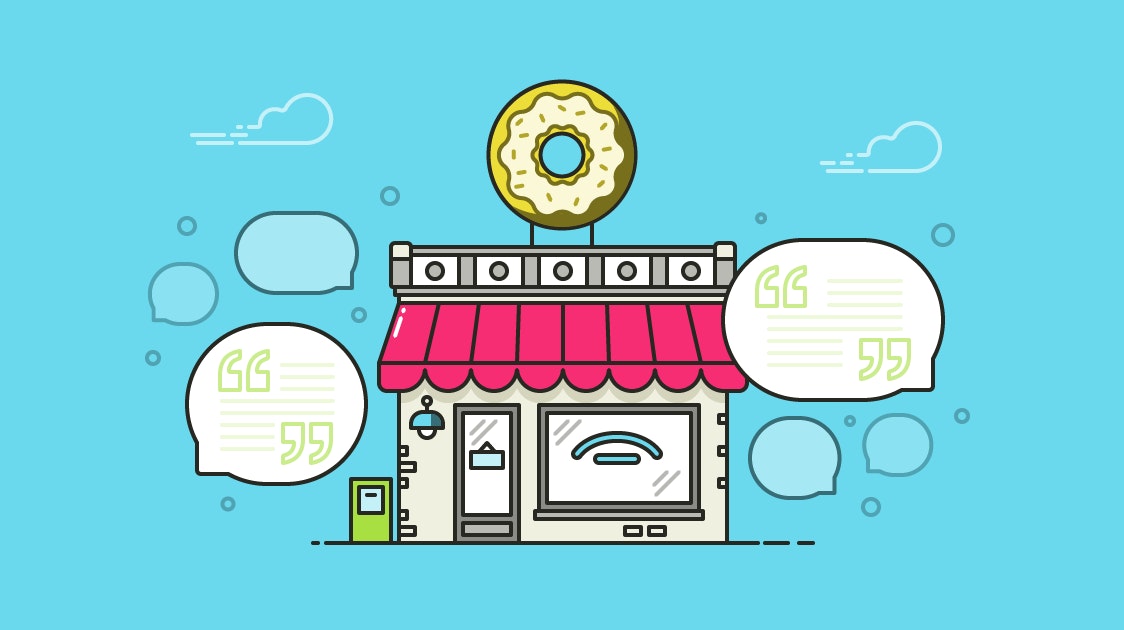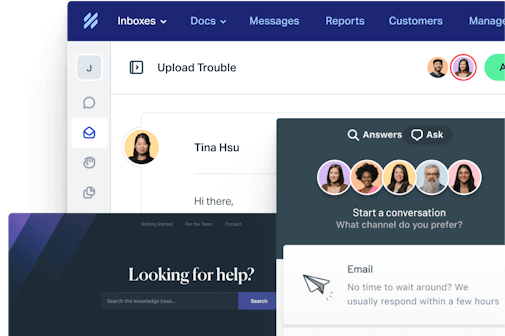Customer testimonials send strong signals of trust because they’re candid endorsements of your product by the people who actually use your product. Your customers will always be more persuasive than you.
The good news: An effective testimonial will do a lot of heavy lifting, and can usually be put to good use throughout your marketing site.
The not-so-good news: Not every testimonial is created equal. While all kind words from customers are appreciated, a great testimonial is special because it comes from a place of sincerity but also feels personal, relatable, specific, and motivational.
The real value of customer testimonials
Testimonials do an oft-overlooked and underappreciated job: they establish your credibility. Checking out a new product can feel like entering uncharted territory. What if people know this product is a bad choice, and you’re just unaware? More powerful than FOMO is the fear of making a mistake.
American showman P.T. Barnum knew a thing or two about the power of praise, reputation, and validity, and his advice is a lesson every business needs to learn:
Nothing draws a crowd quite like a crowd.
No matter how compelling you make your copy or how beautifully you present your product, testimonials remain the most effective way to show that the crowd is on your side, and that people who trust you get the results they are promised. Given their importance, you shouldn’t waste precious space by using half-hearted kudos.
Let's explore some proven principles and examples to help you make the most of your testimonials.
1. Photos can increase perceived trust
Every founder views marketing not as something they do to people, but something they do for people. “Why do I need to justify my copy if what I’m saying is true?” they ask.
Back in reality, everyone has been burned by a company before, through failed promises, misleading messages, and sudden vanishing acts. When a product lets you down it can cost a lot more than the price you paid. This is especially true in B2B, where the time spent getting set up is the biggest commitment of all.
Just because you’re telling the truth doesn’t mean buyers will believe you. They have reservations about switching, and need assurance that what you’re saying is true. Hearing from another customer goes a long way, but seeing a real person alleviates the nagging feeling that the high praise they’re reading is falsified or exaggerated.
Research on increasing perceived trust, or “truthiness,” shows that photos make facts and statements more believable. Take, for example, a picture of a thermometer placed next to the text, “The liquid metal inside a thermometer is magnesium.” The photo increased the amount of people who evaluated the “fact” as true (even though it wasn’t). Steer clear of unethical usage and you can see the positive application of photos: to make honest testimonials feel more trustworthy.

Kissmetrics makes good use of this by putting a face and a name to their lead testimonials, making them more convincing than if text alone was used.
We take a similar approach on our Customers page. In our case, the testimonial is actually a short video interview with each customer, but the practice of putting a face to the name is the same.
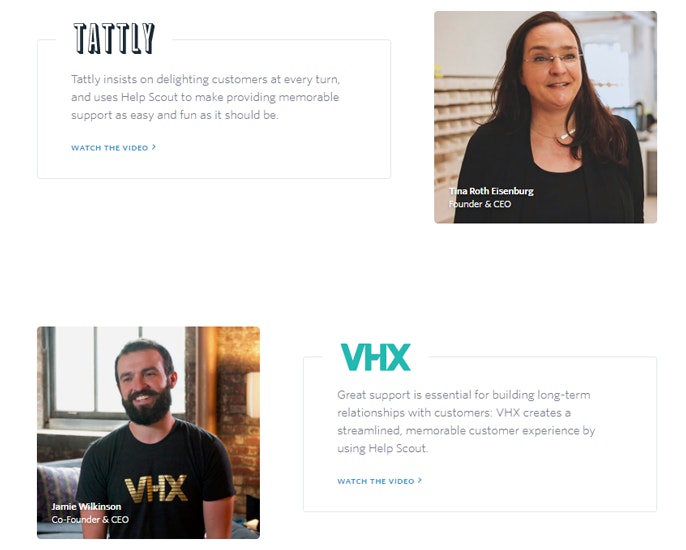
Faces are proven to be one of the most eye-catching elements in all forms of marketing materials, from ads to print to web pages. Research suggests seeing faces can increase the empathy we feel toward other people, even when we've never met them. If you want buyers to give credence to your testimonials, show them a real person.
2. Stories make outcomes relatable and real
Say you’re looking for a new solution for your server status page, and you land on a product with a customer testimonial that reads like this:
“Great product, runs fast and the support is excellent!”
Nice comment, but it’s something we've all seen 100 times before. Cookie-cutter doesn’t quite have the edge we need. Now imagine you come across a competitor, like StatusPage, that showcases a different sort of testimonial.
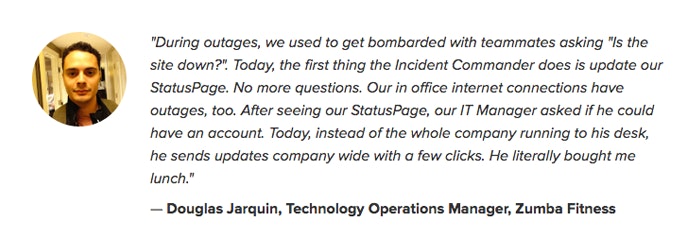
Relatable, right? Like you were reading a real story instead of stock photo gibberish. It invokes the anxiety of having all eyes on you if the network goes down. The idea of an outage that grinds the business to a halt is enough to make your hair stand on end.
The story also sets up the “before, after, bridge” that is so effective in persuasion — start with a vivid description of the pain, end with an enviable, headache-free outcome, and make it obvious how the tool was able to bridge the gap. Although the first example is shorter and may have more “snap,” testimonials are by nature geared towards an interested audience. Favor those that are engaging over those that are dispassionately succinct.
As psychologist Jeremy Dean notes, transportation leads to persuasion. It's easy to see why. Well-told stories wrap us up in the details. They slip in under our radar and persuade us when we least expect it. We’re more likely to listen to a message when it is relayed through a story. According to psychologists Christopher Chabris and Daniel Simons, authors of The Invisible Gorilla, stories can be even more memorable than facts and statistics: “Our ancestors lacked access to huge data sets and experimental methods. By necessity, we learned from specific examples, not by compiling data from many people across a wide range of situations.”
While most of us have a habit of blocking out marketing gimmicks, there is a certain level of suspense we feel when reading a good story, and we usually answer the call to follow it to the end because we want to know, “What happens next?”
3. Precise numbers signal tangible results
If you use data in your customer testimonials, stick to results like 63% or 29% versus a round number like 80% — customers favor exactness.
Professor Malia Mason of Columbia University Business School says using an exact number rather than a round one “signals that you have more knowledge about the value of the good being negotiated." In the context of negotiating for a salary, for instance, odd, specific numbers make you sound like you know exactly what you're worth.
If you're evaluating marketing software to increase customer engagement, you’re going to be inundated with promises to “improve” and “boost” every metric you could want to hear about. Appcues' customer testimonial took a better approach, first by speaking to an end (feature adoption) and not a mean (clicks), and second by using a specific percentage.
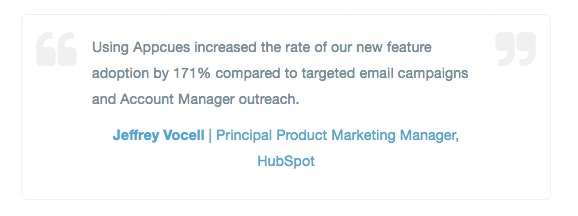
The “awkward” number is likely to be more persuasive because it’s based on detailed facts and figures. This is the precision bias at work: people often confuse accuracy and precision, and they end up believing that because a number is more precise, it's also more accurate. Again, the ethical application is alleviating uncertainty and making the truth more convincing.
Don't sell yourself short by rounding out precision from your success stories. Heighten the perception of accuracy by getting precise with your numbers to make your results not just true, but persuasive, too.
4. Buyers are more receptive to customers they resemble
In trying to please all, he had pleased none.
We know our friends and colleagues will offer honest opinions with our best interests in mind. No advertisement can buy that sort of persuasive effect, no matter the budget. It’s the reason why social signals are so popular on the web today.
However, not every customer will have someone to consult with when purchasing your product. They could be buying it in “isolation,” or without having heard good things from people they know. When that’s the case, most of us implicitly view the next best thing as hearing from people who are similar to us.
Implicit egotism theory is commonly used to describe this bias. Put simply, we usually view ourselves in a positive light, so people like us must be pretty swell, too. We’re generally more interested, trusting, and favorable toward people who reflect who we are or who we want to be.
What does this have to do with a good testimonial? Two things: first, it’s better to feature customers that potential buyers can relate to. Second, and this is more of a paired opinion, it can be useful to “informalize” your testimonials to a certain extent, at least in some places. Having picture-perfect testimonials everywhere can begin to feel premeditated and even artificial, while a collection of unpolished, breezy feedback can feel more authentic.
Gusto's customer page, for example, shows live tweets from real people praising their product. You can click through the profiles to individual feeds to see that these are people like you, not paid shills or the CEO’s alter ego.
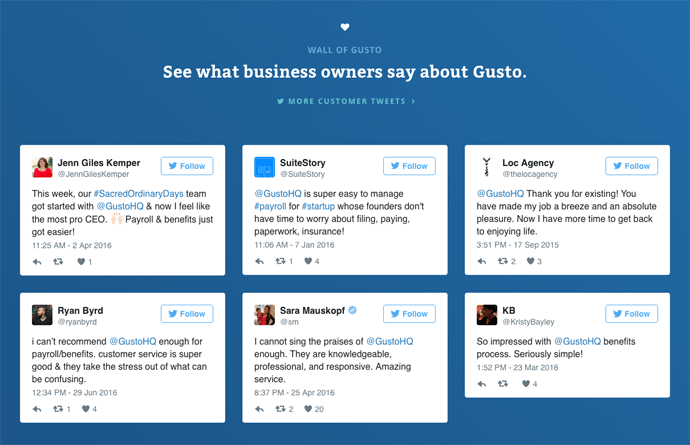
Too often, companies rely on bland reviews from Jane/John Doe, advocate #99217. You probably have ideal customers who are the best fit for you product. You should be appealing to them at every turn, testimonials included.
5. Borrowed authority from big names can instill confidence
The one time to use a testimonial that doesn’t fit this mold is when you want to leverage the Halo effect. It’s a simple principle and mostly common sense: recognizable brands make the things they endorse look better. They instill confidence through familiarity
Consider it the branding equivalent of keeping good company. If your product isn’t a household name (see: 99% of us), it’s helpful, for both buyer and seller, to establish credibility with a few notable customers — especially if you’re a new business. In B2B not only are you selling to the person responsible for the purchase, you may also be selling to their boss. Testimonials from high-profile companies are as useful to them as they are to you.
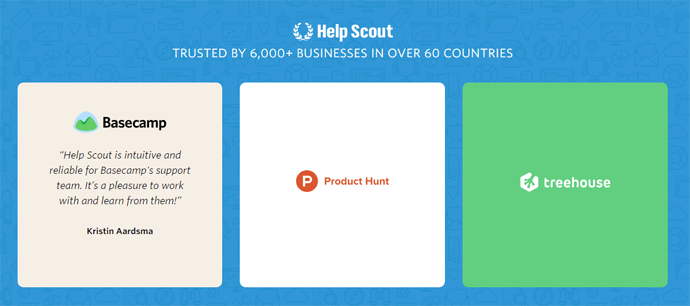
There’s a mix of aspirational persuasion and credibility by association at work with these types of testimonials. On the Help Scout homepage, you’ll see we’ve a rotating section that pairs testimonials, company logos, and our growing customer base into a single form of social proof. The homepage is where most visitors unfamiliar with Help Scout will land, making it an appropriate place to emphasize credibility.
The next step: customer stories
Testimonials are great, but occasionally you need to showcase a more comprehensive problem/solution scenario, and describe the transition to your product in detail. Enter: customer success stories. They take a lot more legwork than finding the perfect excerpt for a testimonial, but the underlying goal is the same: show a real person with relatable problems achieving specific results with your product.


